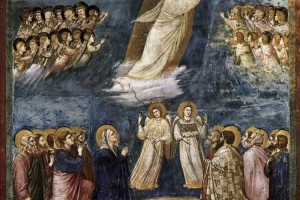In continuation of Matt’s brief theology of Colossians, which focused on the nature of the Church’s new existence in Christ, this entry will focus on a major Christological theme of the letter. The main Christological message is summed up in the famous “Christ Hymn” of Col 1.15-20. Many interpreters of Colossians regard the hymnic material as influenced by Hellenistic-Jewish Wisdom traditions (cf. Philo, Wisdom of Solomon). However, I have argued in the Spring 2011 issue of the Trinity Journal that the “hymn” should be understood to denote the regal status of Christ. I do not have sufficient space to address the arguments for Wisdom traditions as the proper background (something Gordon Fee called “Hogwash” in a personal conversation at the 2010 IBR meeting), so here I will briefly list a few key arguments in favor of a regal interpretation of the hymn, which will help open up the Christology of the letter.
The hymn begins by stating that Christ is the “image” of the invisible God. This harkens back to the beginning of Genesis where God made Adam and Eve to be image-bearers. The meaning of the “image” is provided for us in the text; they were to rule and subdue all of creation (Gen 1.26-28). Thus, the “image” relates to the function of humanity; we were designed to rule on God’s behalf. In other Ancient Near Eastern contexts, kings were understood to be the “images” of the divine, and kings would also place images of themselves wherever their rule extended, despite their absence. Thus, Christ is the “image” of the invisible God particularly in his humanity (hence the contrast with invisible). He is indeed restoring humanity’s rule.
Secondly, the hymn asserts that Christ is the firstborn twice (of creation; of the dead). In Jewish thinking, a position of authority was associated with being the firstborn, and eventually the term could be used metaphorically in order to denote status without regard for the order of one’s birth. Solomon, for instance, was called the “firstborn” of God who was the highest of the kings of the earth (Ps 89.27). Christ is the firstborn in this context, not because he was the first created person, but because he created everything! Therefore, he has all authority over creation. Furthermore, in regards to being the firstborn from the dead the text rings with Davidic overtones as the resurrection is often linked with the Davidic Covenant (Rom 1.4; 1 Cor 15.23-28; Acts 2.22-36; 13.26-37). This connection is made fairly explicit in Colossians since the text notes that Christ was raised and seated at the Father’s right hand in accordance with Ps 110.1 (cf. Col 3.1). Again a little later, Paul calls Christ the “master in heaven” (Col 4.1). Thus, we should understand “firstborn” to denote authority.
Thirdly, Christ is declared to be the “head” of the body, the Church (Col 1.18). Regardless of how one interprets the metaphorical use of “head” in the debate about Women in ministry, here the idea is undoubtedly related to the anatomical understanding of the head as the “supply center” of the body, which includes the idea of source and authority. A few verses later, Paul states that Christ is the head of the hostile powers (Col 2.19). Of course, this must be understood to refer to Christ’s authority over these evil forces. This idea of headship in relation to the Church and the hostile powers is nicely paralleled in Eph 1.20-23 where the subjection of the powers and the authority over the Church is expressed.
Fourthly, many have interpreted the word ἀρχή as “beginning” in Col 1.18b. Depending on the context, ἀρχή can either refer to temporal primacy (i.e. beginning) or primacy of rank. In this context, there is good reason to interpret the word as denoting primacy of rank (i.e. ruler). One good argument for this is that Paul rarely uses the temporal sense of the word (only once in Phil 4.15). Another important comment to make is that the hostile powers in Colossians are the ἀρχαὶ (the same word in the plural; the “rulers”). Thus, it seems quite possible that Paul is stating that Christ is the ruler par excellence. Lastly, this interpretation fits nicely with the regal interpretation of “image.” Verses 15 and 18b essentially introduce the two stanzas of the hymn and both lines are modified by Christ being the “firstborn” (if that sounded confusing open your Bible and notice the parallel). Thus, despite the tendency of modern translations and commentators, the rendering “ruler” best fits the hymn.
Fifthly, the hymn asserts that all of these things are true so that Christ might have preeminence. In my mind, this sums up the meaning of the hymn in its entirety. If preeminence is the telos, this helps confirm the regal interpretation of the other key words of the hymn as well.
After surveying these key terms, it is important to look at the hymn in the context of the letter of Colossians. Of course, just prior to the hymn Paul asserts that believers have been transferred into “the Kingdom of the Son of God’s love.” This line is loaded with regal and Davidic connotations (cf. Ps 2; 2 Sam 7) and functions as an important introduction to the hymn; directing our focus to the Kingdom of Christ. In the broader context of the epistle, it appears that Paul is attempting to set up Christ as the true regal figure of the cosmos. Neither Caesar nor the hostile spiritual forces are superior to him. In fact, there appears to be an intentional parody of Rome. As Caesar would lead his captives in humiliating triumph around Rome, so Christ leads the spiritual forces in triumph through the cross (Col 2.14-15). Instead of the ‘good news’ of Caesar’s reign being spread throughout the known world, the euangelion (Gospel, or good news) of Christ is preached throughout all creation (Col 1.23). Rather than the pax Romana holding sway, the ‘peace of Christ’ rules in the hearts of believers (Col 3.15). Thus, the Christology of Colossians is summed up in one word: Supremacy.
Postscript: It was not my intention to address whether or not Paul wrote the hymnic material or whether or not he wrote the epistle (although I assume both). At the very least, if the hymn was not written by the author of the epistle it still had to be interpreted, and the broader context suggests that the hymn was interpreted as a regal affirmation of Christ.





2 Comments
Leave your reply.